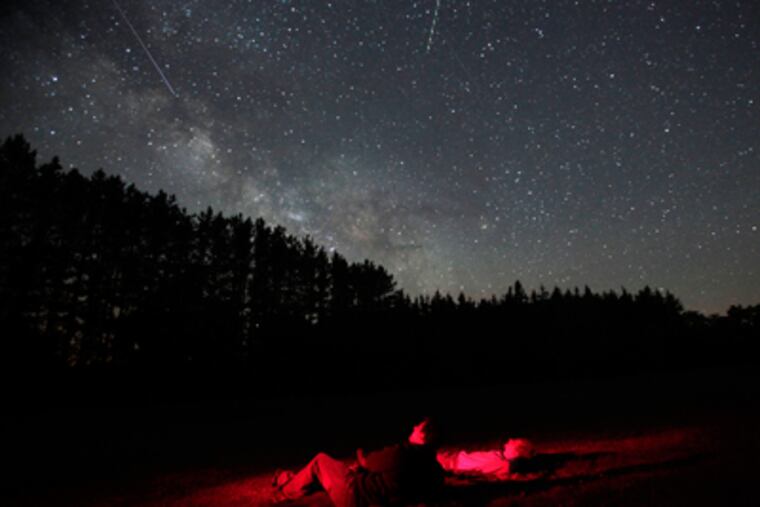Skygazers find nirvana in spot in northern Penna.
CHERRY SPRINGS STATE PARK, Pa. - This is one of the darkest places in the Eastern United States, an oasis of blackness so deep it must be what our ancestors saw at night.

CHERRY SPRINGS STATE PARK, Pa. - This is one of the darkest places in the Eastern United States, an oasis of blackness so deep it must be what our ancestors saw at night.
A little after 9, as twilight turned itself down, Dwight Dulsky, an art teacher and amateur astronomer from Bucks County, saw the first light snap on.
It was the bright star Vega, the master of ceremonies, opening the show on a rare, perfect night, with a clear sky and no moon over the endless, big woods of northern Pennsylvania.
Several dozen stargazers had pitched tents on an open hilltop last week, amid 262,000 acres of state forest, to do what an ever-diminishing number of Americans can do at home: See the night sky in all its brilliance.
"Look! There's Deneb!" Dulsky pointed to the left of Vega. And there was Altair, lower and right, completing the Summer Triangle.
Next came Saturn, then the earliest lights in the constellation Scorpius. Minute by minute, the sky was thicker and thicker with stars.
By 10:30, when full darkness had settled in, the Milky Way - with its billions of stars - was a smoky belt running north to south across the entire sky.
Dulsky, of Perkasie, struggled to put into words what he was seeing. Finally, he decided he could not.
"It's unlike anything you'll see in the Philadelphia suburbs," he said. "It's awesome."
Many 21st-century Americans have never seen what you can see here, 2,300 feet above sea level, in one of the most thickly wooded regions of the Mid-Atlantic.
The nearest town, the tiny Potter County seat of Coudersport, is 500 feet lower and 15 miles away.
At sunset, more deer and turkeys than cars roam the narrow two lanes of Route 44. What little light might intrude from the road is blocked by tall stands of firs.
The International Dark-Sky Association, which lobbies in Washington to curb light pollution, has certified Cherry Springs as one of a handful of "international dark sky parks" in the nation.
What that means, director Bob Parks said, is not only that the park is very, very dark, but also that local organizations are working to keep it that way by turning down lights where possible and capping lights that remain on.
Parks said of Cherry Springs: "It is one of the darkest places east of the Mississippi."
Some dark-sky enthusiasts would hold out for a corner of West Virginia as just as dark or darker. And parts of Acadia National Park in Maine could make a case for bragging rights.
But there aren't many such places. Parks tells the story that when a power-grid failure blacked out much of Northeastern America in 2003, many people called 911 to report smoke in the sky.
"It was the Milky Way," he said. "They had never seen it. People have to go farther and farther out to get what you used to be able to get in your backyard."
The Philadelphia-area campers had driven five hours or more to get here, first on interstates, then on twisting back roads almost to the New York border. Camping was just $11; you put the money in an honor box.
Art Baldwin, a retiree from Northeast Philadelphia who camped with Dulsky as a fellow member of the Bux-Mont Astronomical Association, said that the first time he drove to Cherry Springs, "I was blown away. I had never seen a truly dark site."
Lewis and Clark, the first European Americans to cross the continent, in 1804-06, might have seen a bit darker sky, he said, "but they didn't have high-powered telescopes."
Most of the campers, Baldwin included, had spent a fair share of their disposable income on computerized devices to track and magnify certain stars.
Tibor Mihalovits, a truck driver from near Harrisburg, had set up an 8-inch telescope, a 10-inch telescope, and related equipment that he guessed had cost him $6,000.
Is that all of it? he was asked.
"Oh, no," he said. "I've got more in the car."
He ticked it off: "Focal reducer. Field flattener. Light-pollution filter. Eyepieces. Tube extenders. Two DSLP cameras. Two laptops."
Many of the campers were star experts, or wanted to be.
George Burnley, an engineer from Brownstown, Lancaster County, was on the hunt for globular clusters with his large telescope. Astronomy, he said, is "a steep learning curve."
Ted Friel, a Comcast project manager from Downingtown, felt under-gunned with just a tripod and star tracker on which he had mounted a camera.
But you do not need equipment to look up. The first time he saw the night sky in its full glory, Friel said, he was hooked.
What entrances him, he said, is that it takes hundreds of thousands of years for the light from far objects in the sky to reach Earth.
"When you're looking up, you're looking back in time," he said. "You're seeing things that happened long, long ago. And that's pretty cool."